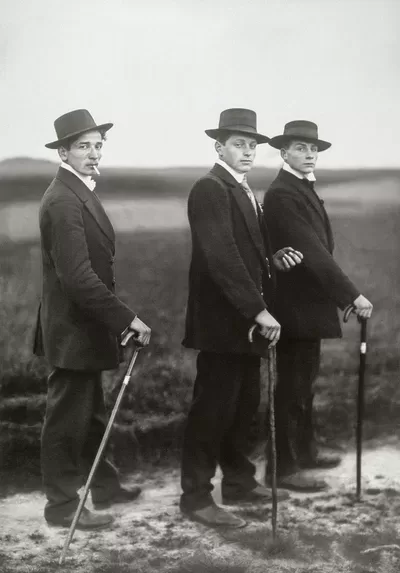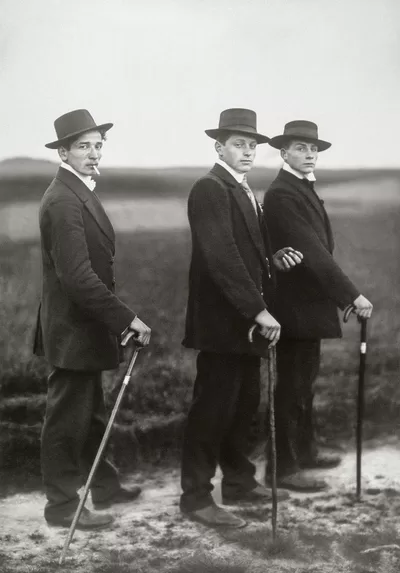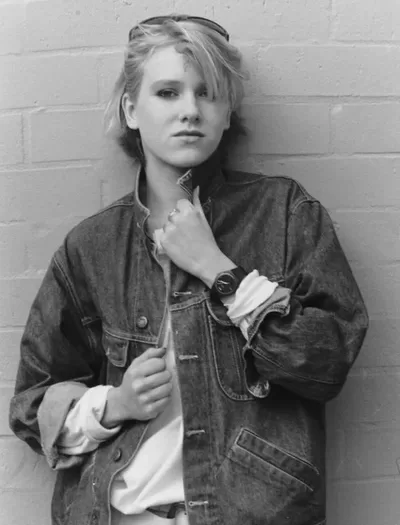During the first semester of the Magnum Photos-Speos Photo School’s “Creative Documentary & Photojournalism Course” we were asked to briefly analyse John Berger’s essay “The Suit and the Photograph” on August Sander, and answer questions on photographers Paul Strand and Henri Cartier Bresson.
About August Sander
1) What idea in this article interested you the most? Expand in a few lines.
The romantic notion of three young German farmers in 1914, dressed in expensive suits they could not – apparently – afford, walking through the mud with confident, determined expressions on their faces on their way to a dance … is just that, a romantic notion.
John Berger’s “Ways of Seeing” (1971 – on Amazon) and his other writings were an important collection of photographic critiques and essays, elevating August Sander’s excellent photographs to the level of fine art.
Berger wrote his essay “The Suit and the Photograph” in 1979. Perhaps Berger’s essays and observations should also be considered in a historical, and more importantly a Marxist, context.
German photographer August Sander’s photographs are clearly in the documentary genre, however Berger’s essay does not address them in that context, instead critiques and examines them solely from the perspective of class.
2) Why Berger is interested in suits? What is the relationship with documentary photography?
“The suit as we know it today developed in Europe as a professional ruling class costume … it was the first ruling class costume to idealise pure sedentary power.”
Berger, a well known Marxist art critic, writes about Sander’s photographs from a Marxist point of view, examining class and their ‘social caste’ … “why is their class so apparent?” “Nobody forced peasants to buy tailored clothes …” Berger clearly saw the suit as a symbol of class, and of the young lower class’s ambitions to rise above their class.
The “three young peasants” in Sander’s photo entitled ‘Young Farmers’ weren’t actually farmers. Two worked in an iron ore mine and one worked in the mine’s office. Sanders knew this, he had photographed the young men and their families previously.
Berger’s essay does not address the photograph in a documentary context as he clearly states “Yet I only want to consider one thing, their suits”. If he had considered their expressions of self confidence and their gentile hands holding their canes, he might have more properly placed them in an historical, documentary context, not influenced by his Marxist bias.
About Paul Strand
What ““ I am ”include all that has made me so”, would mean in relation to the way of making portraits of Paul Strand (according to Berger). Explain in your words.
Berger claims the success of Paul Strand as a photographer was his ability to cox the subject to “invite a narrative” … “I am as you see me” with the assumption that the subject has nothing left to hide, all is revealed to Strand’s camera.
“I am all that has made me so” suggests that the subject’s entire life is revealed in the instant of the photograph. Certainly the subject’s faces reveal a lot about them, the effects that their trials and tribulations have had on how they look in that instant.
What’s the difference, according to Berger, between the goal sought by HCB et Paul Strand within their photographie?
Henri Cartier Bresson’s photographs and Strand’s are the anti-thesis in that HCB’s decisive moment is hunted, stalked and turned into an artistic expressive moment, whereas Strand’s photographs delve deeper into the subject, placing them in an historical context, and revealing more about the character, telling more of their story. HCB’s decisive moment as art versus Strand’s documentary story telling.


The Suit and The Photograph by John Berger
USES OF PHOTOGRAPHY
What did August Sander tell his sitters before he took their pictures? And how did he say it so that they all believed him in the same way?
They each look at the camera with the same expression in their eyes. Insofar as there are differences, these are the results of the sitter’s experience and character – the priest has lived a different life from the paper-hanger; but to all of them Sander’s camera represents the same thing.
Did he simply say that their photographs were going to be a recorded part of history? And did he refer to history in such a way that their vanity and shyness dropped away, so that they looked into the lens telling themselves, using a strange historical tense: I looked like this.We cannot know. We simply have to recognise the uniqueness of his work, which he planned with the overall title of ”Man of the 20th Century.” His full aim was to find, around Cologne in the area in which he was born in 1876, archetypes to represent every possible type, social class, sub-class, job, vocation, privilege.
He hoped to take, in all, 600 portraits. His project was cut short by Hitler’s Third Reich.
His son Erich, a socialist and ant1-nazi was sent to a concentration camp where he died. The father hid his archives in the countryside. What remains today is an extraordinary social and human document. No other photographer, taking portraits of his own countrymen, has ever been so translucently documentary.
Walter Benjamin wrote in 1931 about Sander’s work:
”It was not as a scholar, advised by race theoris1s or social researchers, that the author [Sander] undertook his enormous task, but, in the publisher’s words, ‘as the result of immediate observation.’ It is indeed unprejudiced observation, bold and at the same time delicate, very much in the spirit of Goethe’s remark: ‘There is a delicate form of the empirical which identifies itself so intimately with its object that it thereby becomes theory.’
Accordingly it is quite proper that an observer like Doblin should light upon precisely the scientific aspects of this opus and point out: ‘Just as there is a comparative anatomy which enables one to understand the nature and history of organs, so here the photographer has produced a comparative photography. thereby gaining a scientific standpoint which places him beyond the photographer of detail.’ It would be lamentable if comic circumstances prevented the further publication of this extraordinary corpus … Sander’s work is more than a picture book, it is an atlas of instruction.”
In the inquiring spirit of Benjamin’s remarks I want to examine Sander’s well-known photograph of three young peasants on the road in the evening, going to a dance. There is as much descriptive iriformation in this image as in pages by a descriptive master like Zola. Yet I only want to consider one thing: their suits.
The date is 1914. The three young men belong, at the very most, to the second generation who ever wore such suits in the European countryside. Twenty or 30 years earlier, such clothes did not exist at a price which peasants could afford. Among the young today, formal dark suits have become rare in the villages of at least western Europe. But for most of this century most peasants – and most workers – wore dark three-piece suits on ceremonial occasions, Sundays and fetes.
When I go to a funeral in the village where I live, the men of my age and older are still wearing them. Of course there have been modifications of fashion: the width of trousers and lapels, the length of jackets change. Yet the physical character of the suit and its message does not change.
Let us first consider its physical character. Or, more precisely, its physical character when worn by village peasants. And to make generalisation more convincing, let us look at a second photograph of a village band.
Sander took this group portrait in 1913. yet it could well han been the band at the dance for which the three with their walking sticks are setting out along the road. Now make an experiment. Block out the faces of the band with a piece of paper, and consider only their clothed bodies.
By no stretch of the imagination can you believe that these bodies belong to the middle or ruling class. They might belong to workers, rather than peasants: but otherwise there is no doubt. Nor is the clue their hands – as it would be if you could touch them.
Then why is their class so apparent? Is it a question of fashion and the quality of the cloth of their suits? In real life such details would be telling. In a small black and white photograph they are not very evident. Yet the static photograph shows, perhaps more vividly than in life, the fundamental reason why the suits, far from disguising the social class of those who wore them, underlined and emphasised it.
Their suits deform them. Wearing them, they look as though they were physically mis-shapen. A past style in clothes often looks absurd until it is re-incorporated into fashion. Indeed the economic logic of fashion depends on making the old-fashioned look absurd. But here we are not faced primarily with that kind of absurdity; here the clothes look less absurd, less “abnormal” than the men’s bodies which are in them.
The musicians give the impression of being uncoordinated, bandy-Iegged, barrel-chested, low-arsed, twisted or scalene. The violinist on the right is made to look almost like a dwarf. None of their abnormalities is extreme. They do not provoke pity. They are just sufficient to undermine physical dignity. We look at bodies which appear coarse, clumsy, brute-like. And incorrigibly so.
Now make the experiment the other \Vay round. Cover the bodies of the band and look on!y at their faces. They are countrv faces. obodv could suppose that they are a group of bar;isters or manaiing directors. They are five men from a village who like to make music and do so with a certain self-respect. As we look at the faces we can imagine what the bodies vvould look like. And what we imagine is quite different from what we have just seen. In imagination we see them as their parents might remember them when absent. We accord them the normal dignity they have.
To make the point clearer, let us now consider an image where tailored clothes, instead of deforming, preserve the physical identity and therefore the natural authority of those wearing them. I have deliberately chosen a Sander photograph which looks old-fashioned and could easily lend itself to parody: the photograph of four Protestant missionaries in 1931.
Despite the portentousness, It is not even necessary to make the experiment of blocking out the faces. It is clear that here the suits actually confirm and enhance the physical presence of those wearing them. The clothes convey the same message as the faces and as the history of the bodies they hide. Suits, experience, social formation and function coincide.
Look back now at the three on the road to the dance. Their hands look too big, their bodies too thin, their legs too short. (They use their walking sticks as though they were driving cattle.) We can make the same experiment with the faces and the effect is exactly the same as with the band. They can wear only their hats as if they suited them.
Where does this lead us? Simply to the conclusion that peasants can’t buy good suits and don’t know how to wear them? No, what is at issue here is a graphic, if small, example (perhaps one of the most graphic which exists) of what Gramsci called class hegemony. Let us look at the contradictions involved more closely.
Most peasants, if not suffering from malnutrition, are physically strong and well-developed. Well-developed because of the very varied hard physical work they do. It would be too simple to make a list of physical characteristics – broad hands through working with them from a very early age, broad shoulders relative to the body through the habit of carrying, and so on. In fact many variations and exceptions also exist. One can, however, speak of a characteristic physical rhythm which most peasants, both women and men, acquire.
This rhythm is directly related to the energy demanded by the amount of work which has to be done in a day, and is reflected in typical physical movements and stance. It is an extended sweeping rhythm. Not necessarily slow. The traditional acts of scything or sawing may exemplify it. The way peasants ride horses makes it distinctive, as also the way they walk, as if testing the earth with each stride. In addition peasants possess a special physical dignity: this is determined by a kind of functionalism, a way of being fully at home in effort.
The suit, as we know it today, developed in Europe as a professional ruling class costume in the last third of the 19th century. Almost anonymous as a uniform, it was the first ruling class costume to idealise purely sedentary power. The pmyer of the administrator and conference table. Essentially the suit was made for the gestures of talking and calculating abstractly. (As distinct, compared to previous upper class costumes, from the gestures of riding, hunting, dancing. duelling.)
It was the English gentleman, with all the apparent restraint which that new stereotype implied, who launched the suit. It was a costume which inhibited vigorous action, and which action ruffled, uncreased and spoilt. “Horses sweat, men perspire and women glow.’· Bv the turn of the century and increasingly after the first w;rld war, the suit was· ass produced for mass urban and rural markets.
The physical contradiction is obvious. Bodies which are fully at home in effort, bodies which are used to extended sweeping movement: clothes idealising the sedentary, the discrete, the effortless. I would be the last to argue for a return to traditional peasant costumes. Any such return is bound to be escapist, for these costumes were a form of capital handed down through generations, and in the world today, in which every corner is dominated by the market, such a principle is anachronistic.
We can note, however, how traditional peasant working or ceremonial clothes respected the specific character of the bodies they were clothing. They were in general loose, and only tight in places where they were gathered to allow for freer movement. They were the antithesis of tailored clothes, clothes cut to follow the idealised shape of a more or less stationary body and then to hang from it!
Yet nobody forced peasants to buy suits, and the three on their way to the dance are clearly proud of them. They wear them with a kind of panache. This is exactly why the suit might become a classic and easily taught example of class hegemony.
Villagers – and, in a different way, city workers – were persuaded to choose suits. By publicity. By pictures. By the new mass media. By salesmen. By example. By the sight of new kinds of travellers. And also by political developments of accommodation and state central organisation.
For example: in 1900, on the occasion of the great Universal Exhibition, all the mayors of France were, for the first time ever, invited to a banquet in Paris. Most of them were the peasant mayors of village communes. Nearly 30,000 came’. And, naturally, for the occasion the vast majority wore suits.
The working classes – but peasants were simpler and more na·ive about it than workers – came to accept as their own certain standards of the class that ruled over them – in this case standards of chic and sartorial worthiness. At the same time their very acceptance of these standards, their very conforming to these norms which had nothing to do with either their own inheritance or their daily experience, condemned them, within the system of those standards, to being always, and recognisably to the classes above them, second-rate, clumsy, uncouth, defensive. That indeed is to succumb to a cultural hegemony.
Perhaps one can neverthcless propose that when the three arrived and had drunk a beer or two, and had eyed the girls (whose clothes had not yet changed so drastically), they hung up their jackets, took off their ties, and danced, maybe wearing their hats, until the morning and the next day’s work.
Related stories
Covid anti-vaccine pass sanitaire Paris protest
French wine lovers love Montmartre Grape Harvest Festival
Paris Flower Market, Marché aux Fleurs – Reine Elizabeth II
Parisian Street Art in Support of Ukraine
Gregory Halpern “somewhere between the documentary and fine art”






